“I did not realize how long a trip this was going to be. I thought it was just a bit farther than the Bahamas.”-Anonymous crew, Two Fish.
We all had a good chuckle at our crew’s comment, but a day earlier our arrival looked much bleaker. The team was carefully chosen for complimentary skills, personality and endurance. As Shackleton said: “Men wanted for hazardous journey. Low wages, bitter cold, long hours of complete darkness. Safe return doubtful. Honour and recognition in event of success.” David is an ocean-going captain with great fix-it skills and a strong passion for fishing. Tim is a former avid sailboat racer and very comfortable in the galley. Charles is Mr. Positive and a true adventurer at heart. He is the owner of the next Antares to splash.
Before a passage making vessel leaves the dock, there are a litany of preparations required. You can get so wrapped up in preparations that you forget to leave the dock. Two Fish and her systems received plenty of maintenance while in Stuart. The engines, water maker, and rigging were all inspected and tuned. Nothing cleans turning blocks better than some soapy water followed by gallons of high pressure water.
Gail was amazing at setting up the boats stores. She started with input from the crew members’ dietary requirements and tastes. She over-bought on everything, so if you see Two Fish feel free to ask for a Cliff Bar. We are thinking of using them as fishing lures. She cooked 5 dishes, each frozen into 2 nights of easy to microwave portions. The fridge also had pasta salad, sandwich meats, pudding, cheese and much more. The meals were:
Beef chili with plenty of vegetables (Got rave reviews), Chick Pea stew with cheese (Was used as a side order), Lentils with salami and vegetables (rated #1), Baked Ziti (Fell short of potential since I over microwaved), and Cous Cous with Tofu (Was never eaten since the crew could never get excited about Tofu)
The crew assembled on the 9th of January and the immediate topic of discussion was the large waves being recorded at the sea buoy just outside Stuart. I had made the decision earlier in the day that Two Fish would stay in harbor for 2 days. The 10th would have been a bumpy crossing of the gulf stream and would have set us up for 2 days of very strong and unusual headwinds. The GRIBs predicted that a 2 day delay would reward us with much kinder conditions but unusual weather.
Casting Off
- Cast off
- Spin the boat in reverse
- Over the horizon
Getting off the dock is the hardest part of any voyage. When I would travel for work, I would miss Gail more on the car ride to the airport than any other time. Same with boat deliveries. I do not know how the racers in the around the world race (Volvo) can leave home for such long stretches. Technically, I wasn’t leaving home rather our home was leaving without Gail.
I could sense a bit of tension in the crew before the big trip. The usual fears exists hidden under the surface. Will I get sea sick? Will I be comfortable? The crew’s concerns go away quickly when the boat gets underway. The overused analogy is that football players need to get their first hit under the belt for the tension to go away. Since we had no plans for hitting aboard Two Fish, our first sail hoist would have to do for tension removal.
Our loved ones wished us a last good bye and we cast off. We pivoted on the bow line and spun the boat 180 degrees in 15 knots of breeze. We avoided marina hazards and were off for a true adventure. An ocean passage that many discuss, dream of but never get a chance to undertake. Will our diesel engines behave? Will I choose a good route? Will the waves tower 15 feet when crossing the Gulf Stream? I had to stop with the “will” mentality and let us start sailing. David, a Stuart local, navigated to the inlet avoiding the many shallows. We hoisted the mainsail after 4 miles on the St Lucie River. Charles did a great job holding station and avoiding boat traffic, while Tim and David hoisted the main with one reef. The main would add power and stability for our inlet crossing. Nearing the inlet David asked “I hope it is high tide? The waves are breaking over the breakwater. He went on to say “that is not good if it is low tide.” I sheepishly responded that the tide was one-third off of low as I started to look closer at the breaking waves. But as we approached, we noticed that waves would not be an issue for Two Fish. Her six foot topsides kept us dry as we crossed out into the ocean.
I wrote a long post of the routing plan (click here to read it) for this trip but this is the basic summary.
1) Go directly east for 800 miles, then turn right 90 degrees and head south 600 miles. This route avoids the ugly trade winds from the east that are located south of Stuart. A great blog post was written by the crew of Indigo Moon on this path.
2) Have lots of diesel. We wanted to be able to motor in light air so we loaded the boat with a record 17 jerry cans. The boat’s water line dropped from this weight and the boat was “popping a wheelie” as the stern sunk more than the bow.
This plan would go under many modifications and spawn a new lexicon during the trip.
I thought to myself “I think everyone is a bit green” as we sailed in very confused 5 foot seas. In 18 knots of breeze we were beating to reach the northern tip of the Abacos, the northernmost islands of the Bahamas. We had a reef in the main and the full genoa drawing us across the Gulf Stream. The wind direction prevented us from pointing any more to the east but we were being swept off course. It looked as if we were heading to Norfolk, VA. At one point Gail sent me a satellite text “We are watching your track on the big screen TV. Why are you heading so far north?” The 3 to 4 knots of the Gulf Stream were not a surprise but still frustrating. The objective is to get our latitude from 27 North to 18 North ,but instead the number was climbing. I kept this depressing fact to myself. However, the crew are no dummies and our track was no secret. We encountered few ship crossings and everyone enjoyed tracking the closest point of approach(CPA) and time to CPA(TCPA) of targets. Usually, we like to keep 1 nautical mile away from target. Tim’s watch saw a tanker cross our bow, but we had no need to alter course.
David was eager to get the fishing poles out and within hours, we got a strike. I was at the helm and heard the reel running with a ferocity I had never heard before. I assumed David had set the reel with little tension allowing the fish to pull out much line. I decided to slow the boat to aid in the fishing mission, which I rarely do. Genoa furled and course adjusted the boat was traveling at 2 knots or less. The line was still running. The reel was going to run out of line. What the heck have we hooked? A shark, a submarine? With a bit of line to spare, David stopped the progress of the fish and started reeling in. David, Charles and Tim all worked the reel. This was exciting stuff, what will our bounty from the sea bring us?
- David teaching Tim to fish with socks
- Charles working the rod
- Marlin Fighting
- Black Marlin with sail extended
- Marlin’s new profile photo for Facebook
- Release of marlin
The fish was too large for our appetites so we released the fish with a few kind words. Despite the lack of dinner, the excitement lifted everyone’s spirits. But soon that positive emotion would ebb. During the night the sea state progressively got worse and more confused. We rolled up the Genoa to point more towards the East. My rule of thumb for motor sailing is if the angle of the wind to the boat is less than 30 degrees, put away the sails. From 30 to 50 degrees, hoist the Main sail, beyond 50, use the Main and Genoa. We played with our sail combination and angle to the wind to find a more efficient way around the tip of the Abacos. The tug of the Gulf Stream should have abated, but the water temperature and speed indicated that we were still in its grip.
We tried everything to fight our way East/Southeast. We tacked, with the bow pointed almost due South, but the Gulf Stream reduced our speed to less than 3 knots. After an hour, we tacked back. Since you are never supposed to swim against the riptide, I thought, so you should not sail against the Gulf Stream. The boat moved better but we headed too far north. Neither tack gave much satisfaction. The night was spent dodging the predicted thunderstorm cells that showed up nicely on the long range radar. We dodged most of the them and the few that caught Two Fish brought winds in the low 20s and soaking rain, but no lightning. The GRIB (weather) files stated that CAPE (measure of thunderstorm likelihood) was at a high reading. That night I wrote Gail a brief satellite text “Slow run. Magic 8 ball ETA is 15 more days. All asleep. I am in the full enclosure with strong rain giving the boat a good wash. 17 knot headwind. Weather file failed to download.” Gail kindly replied with a brief weather forecast, predicting better conditions were on their way. She also discovered that my GRIB (weather data) provider was suffering from a hacker attack. Of all the weeks! No problem, I used my back up GRIB viewer. I had gotten soaked during one of the squalls, so changed into fresh clothes before going to bed.
We had been at sea for almost 24 hours, travelling at less than half our normal speed. This was the beginning of some tough hours for the navigator. We had planned for a maximum passage of 14 days. The 2 day delay reduced our window to 12 days. While on my first morning watch, the horror of our slow progress sunk in. The navigation computer showed an ETA in 18 days. That is almost February! I started to go through our options. Start a second engine to fight the current. No thanks, as we need to save our diesel. Shorten the trip. Too early to panic? Motor 300 miles at full speed to San Salvador or somewhere else in the Bahamas to refuel? This would mean a late night arrival and a long wait for the fuel dock to open. I decided to press on, knowing that the current could not trap us forever. Patience is key on a long passage.
Settling In
The log book from the second day at sea is littered with speed over ground recordings of 4 knots. The remarks are benign “Saw ship pass”, “Nearest point to the Abacos” “Paddle wheel indicates Gulf Stream is still pulling us North”
On the morning of our departure, I had reattached the fuel hose on our port engine leading from the feed pump to the manual pump. A small amount of diesel was still leaking from the area of the barb. We chose to run the starboard engine exclusively until we could address the leak in calm seas. Diesel fumes and rough seas wobble even the saltiest of sailor’s stomachs.
Two Fish and her crew pressed on in light air with only motors. The crew were great and did not speak of the elephant in the room. Were we ever going to round the Abacos? Can we get an airlift out? As night arrived for the second time on the trip we still had not matched our first day’s goal. But I had a plan! If we took a short cut and traveled on the direct route, rather than due East and the South, we could capture back our lost time. This could be a risky maneuver, since if the traditional trade winds filled in at 20 knots from the east, we might have a 900 mile trip from hell. The GRIBs were encouraging me to take the short cut, as two TROFs were holding a high pressure system across our intended short cut. The waves should die down, the current disappear and we should be able to motor straight to the BVI. The “ifs”, “ands”, or, “buts” in our plan created some apprehension, but I decided to give it a shot. If the Easteries looked likely to appear then I would turn immediately to the East, to stay in the lighter portions. We called this move the stair-step. The reverse stair-step also entered our lexicon.
Tim held a star gazing class while we passed the Abacos. It got rave reviews as he came equipped with a laser pointer that allowed for easy identification. He seemed to know a limitless number of objects in the sky, pointing out stars, galaxies and a passing comet. However, our reality was still a bit bleak-as he came off watch, Tim remarked in the log book that our speed was barely above 3 knots and we were not headed to the BVI.
In my midnight log entry, I make it official: “Pressure is mounting. ETA Jan 25 (11 days). WTF. “ But I later wrote in the same log entry “We have a plan. Motor or motor sail a course of 125 degrees. Do stair-step if strong South-easterlies fill in.” We had access to weather routers on the trip but this unusual weather pattern had them confused. They insisted that going East was key to protect us from strong trade winds we would encounter once we werecloser to the BVI. We respectfully chose to go our own route. I shared this risk with the crew and they were upbeat about taking the shortcut. Our ETA was improving, not because of boat speed rather my shortening of the route to reflect the new plan. I did admit my accounting fraud to the crew but I suspect they figured it out on their own.
Tim noted in the log that we passed Fox Island Radio tower, tallest structure on the Abacos. At night it was only a flashing light. We couldn’t turn yet. David was forced to tack to the north east on his watch as we were headed too close to the Abacos. Good to avoid lee shores in the middle of the night, but depressing to be going the wrong way again. The breeze was now South East as one of the weather reports had predicted. This would be one of the few times the weather gurus got it right. The job of a weather man is not easy. The crew was joking that we should ask for a refund. I was just looking for a chance to try our new strategy, while wondering whether we would be Easting forever.
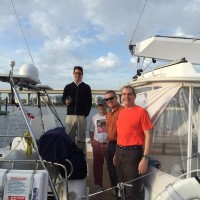
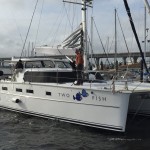
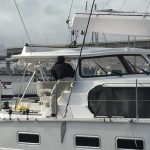
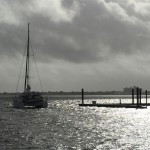
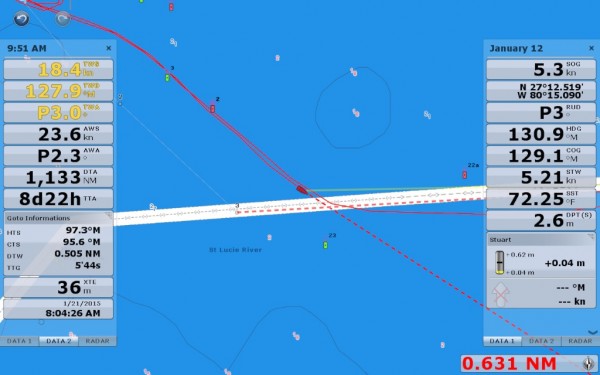
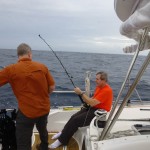
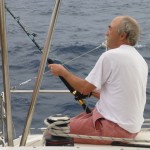
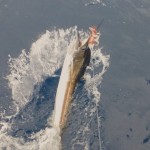
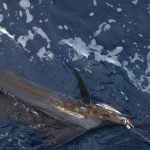
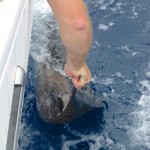
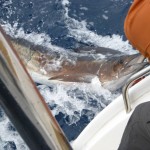
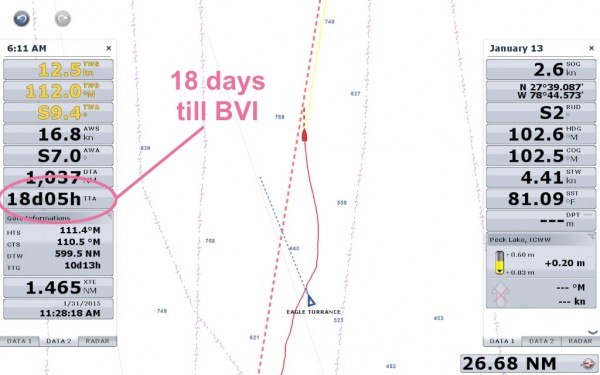
Comments are closed.